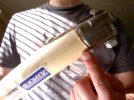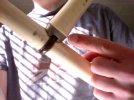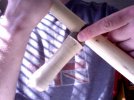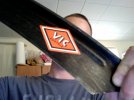Just took the new grass blade for a spin on my vintage snath to see how it would fare. My overall impressions below are comparing a modern economy blade to fine vintage examples, so bear that in mind if I sound a bit negative. This is a natural consequence of the stretch of comparison.
It's very lightweight (even lighter than my Rixford) and pleasing in that regard. The tang is square set to the blade, and the blade seems a hair softer than my Rixford and rapidly raised a bur on the coarser belts of the sander, but polished up well enough on the finest belt. I consider the hardness adequate, though I would prefer it 1-3 points harder. The length seems to be measured from the tip to the back corner of the turn of the tang, rather than the length of the blade region alone. Thus, the effective cutting length is really more like 27.5" rather than a true 30" The beard of the blade is formed about 1/4" too far out from the turn of the tang. This increases the tendency for grass to become caught in this region, and it would benefit from a hole at the base of the blade for the formation of a grass nail to prevent this. The tang length is about 1/2" too short (at least for my vintage snath's mounting collar) to make bending the tang an easy feat, as it would have be a twist at the shank rather than a straight bend at the top of the tang before the turn.
In use I found the lack of a angled tang made the work more difficult, as is to be expected. The blade also had the tendency to chatter, and this is for a couple of reasons. The thinness of the blade makes it more susceptible, for starters, but just means that the following design elements more noticeable in their effect. The rib and the bead of the web are not as deeply set as they could be. They are adequate, and actually deeper than I expected, but a deeper bead and rib would increase rigidity and minimize chatter--however this is an understandable sacrifice in the design to help keep the cost low as the market for scythes is not what it used to be. The biggest issue is that the blade is not curved enough, which minimizes the slicing action through the cut and "tugs" the point. The point of the blade should be dropped at least 1 & 1/2" to allow it to neatly enter the grass. I had the blade in a closed set during this experiment and still suffered tugging because of the overly straight blade.
Overall, the piece is nice and light, and it gets the job done. However, there are a few elements that prevent it from performing like it could. I'll be passing my findings along to Seymour and we'll see if/how they respond.










